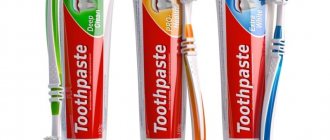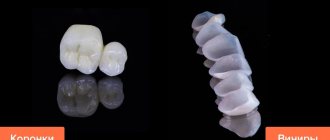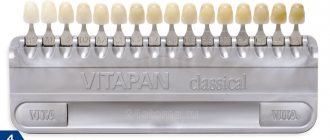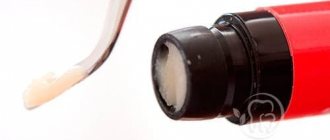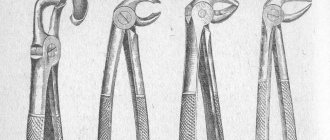How to choose?
Acrylic Nylon AcryFree Comparison of polymers Metal ceramics Metal plastic Ceramics Zirconium dioxide Comparison of fixed dentures Composite Doctors Works Although orthopedics as a science was formed not so long ago, people have been practicing dental prosthetics since ancient times. Animal bones, semi-precious stones, hard wood - everything that ancient doctors did not use as prosthetic material. But the methods of fastening were quite monotonous - using gold, less often silver, wire.
What are dentures made of now? The composition for prosthetics is selected for a specific clinical case, taking into account the patient’s wishes, indications and contraindications.
What materials are dentures made from?
Today, dentists have a sufficient amount of materials for making dentures in their arsenal. Each of them is used for different purposes. Materials for dental crowns and dentures differ in cost, appearance and other characteristics, which allows you to choose a design identical to natural teeth. Since human health depends on the quality of products, strict requirements are imposed on materials for prosthetics:
- hypoallergenic;
- strength;
- non-toxic;
- lack of smell and taste;
- suitable color palette;
- compatibility with the tissues of the oral mucosa.
So, what materials are dentures made from? We invite you to familiarize yourself with the main modern materials for dental prosthetics.
- Plastic.
Temporary crowns and removable dentures are made from its varieties, since this material is short-lived, and after a couple of years the product has to be replaced with a new one. The most popular are affordable dentures made of acrylic and nylon. - Metal.
Cobalt-chromium, nickel-chromium and gold-containing alloys are widely used for dentures. They are used to make frames for crowns, clasp and solid metal structures without ceramic coating. - Zirconium oxide or dioxide.
Durable white material, ideal for making dentures for chewing teeth. To add a natural shine, zirconium dioxide crowns on the front teeth are often coated with a ceramic layer. - Ceramics.
In its properties, this material is closer than others to natural tooth enamel. It transmits light well and is easy to tint to the desired shade, so the color of dentures made from this material will be as natural as possible. The only disadvantage of ceramics is its lack of strength, but today a solution to this problem has been found in dentistry - the use of glass ceramics (lithium disilicate). Reliable and aesthetic modern E-Max crowns are made from it.
Types of materials for restorations
Today, the following main types of materials are distinguished:
- Basic
, they are also usually called structural;
- Auxiliary
.
The first type includes all the materials that are required to create a prosthesis.
Peculiarities
Among the main materials included in this group are glass ceramics, porcelain, plastics and various metals and alloys.
During restoration, it is necessary to achieve rather contradictory qualities. So safety must be combined with strength and aesthetics.
The highest strength indicator is found in metal products. The alloys from which these prostheses are made have the highest strength. They cope well with stress and abrasion. The values obtained will depend on the metal itself. Titanium is considered the best. Its widespread use allows the production of various fasteners and screws.
At the same time, alloys do not have the ability to convey aesthetics, since they do not have transparency. Even if their outer part is covered with cladding, the restoration itself will not look beautiful. Through surfaces with a lower density, metals will be illuminated. These manifestations will be detected with close attention or a certain viewing angle.
Safety in this case will be guaranteed by the use of certain alloys and their grades. They do not cause allergic reactions and there is no release of compounds hazardous to humans.
There is a whole set of parameters inherent in dental materials:
- Ease of processing
. Substances should be selected so that processing is low cost and simple. This will greatly simplify the production of components. But not all metals are susceptible to these effects. For example, the use of titanium will require more powerful equipment, as well as the presence of special installations that will ensure proper cutting conditions.
- Survivability.
All materials do not cause rejection. An exception may be the patient’s individual intolerance;
- Corrosion resistance.
Preservation of all its properties under the influence of food, saliva and other substances.
Metals
This group of elements has a number of distinctive features that set them apart from others.
Among them are the following variables:
- High plasticity rates;
- Lack of transparency;
- With appropriate processing, it is possible to achieve a shiny surface;
- Increased heat conductivity;
- Malleability of elements;
- High electrical conductivity.
These aspects are inherent in all types of metals that have found their use in dentistry. In this case, metals are divided into non-ferrous and ferrous. All ferrous metals are dark gray in color and have a higher melting point and increased density. For non-ferrous metals, the shades depend on the type chosen. They are more ductile and have low hardness.
Non-ferrous metals are also divided into noble and rare earth. There is also a division according to the structure of their crystal lattice:
- The most common is the cubic body-centered lattice;
- Next comes cubic face-centered;
- The next one is close-packed hexagonal.
Alloys
When using a combination of several metals, it is possible to obtain a separate alloy that will have characteristics not inherent in other metals. There are both metallic and non-metallic alloys. If an alloy contains any metal in its composition, then it is classified as metallic.
Alloys are divided into certain subgroups depending on the number of components contained in their composition:
- Binary
– in the case when the composition contains two elements;
- Triple
– if there are three elements.
Alloys using more elements are possible.
There are several scenarios in which atoms inside alloys interact with each other. If a substance has a different grain structure after melting and has these characteristics, then they are usually called mechanical mixtures. Solid solutions arise when particles completely dissolve in each other. It is solid solutions that make up the majority of alloys used in dentistry. These include gold alloys.
The next classification by which the separation is carried out is the melting point:
- Refractory, not classified as noble, have a temperature of more than 1200 degrees;
- Refractory, classified as noble, melt at temperatures up to 1100 degrees;
- Low-melting materials melt at temperatures up to 300 degrees.
Noble metals
The existing ISO standard classifies these alloys as those that contain from 25 to 75 percent platinum or gold. Due to their increased resistance to corrosion, these alloys are very popular.
In order to create a prosthesis, the following types can be used:
- 750 sample - contains 75% gold and has a melting point of about 800 degrees;
- If the composition contains platinum, then alloys are produced with 60 or 75% gold;
- 850 standard, which contains 85% gold. This material is used for the manufacture of systems and cladding for porcelain crowns;
- Fineness of 900 and above, which contains 91% gold. This option is used for casting bridges and crowns.
The melting point of the third and fourth species is 1050 degrees.
All gold alloys are divided into 4 main groups, divided according to their strength from low to ultra-high. Alloys with low and medium strength are suitable for creating inlays with a single surface. High-strength alloys are used to make short bridges, cast pins, onlays and crowns. Ultra-strong alloys are also used for the production of pins, bridges and a number of other elements.
Base metals
Dentists can use various base metals as a basis for the manufacture of certain types of alloys.
In Russia, chromium-nickel stainless steel has found widespread use in the manufacture of prosthetics. At the same time, the nickel contained in its composition is not always biocompatible, which can lead to allergic reactions. In this case, the material can be used to create structures with a cast form. These can be crowns, bridges, clasps and other orthodontic preparations.
Cobalt-chrome and cobalt-chromium-molybdenum alloys are also widely used in dentistry. This group is quite widely used for the manufacture of crowns, bridges and various structures. The material has a fairly simple degree of sheen, which is considered its main advantage. Maximum precision is achieved in the manufacture of components.
The use of titanium is allowed in two possible forms. The first implies its use in its pure form, and the second as part of an alloy. It is suitable for the manufacture of various dental elements. This metal is also widely used for the production of dental instruments. There are several grades of titanium, each of which is intended for specific purposes.
The next way to use titanium is to add it to materials widely used in dentistry. Titanium has a high melting point, so the production of products from it is a rather labor-intensive process. Shrinkage is also observed, which leads to a decrease in the accuracy of the product. The use of vacuum or inert gases allows the error to be reduced to a minimum.
Among the disadvantages of titanium, one can also note its reaction with the mold used for casting. As a result, scale forms on the mold. The fit of the components is deteriorated due to this problem. Modern techniques are constantly expanding the list of components and today it is possible to work with almost any substance.
What is the best material for prosthetics?
As you can see, the choice of modern materials for dentures is quite large. It is impossible to say definitively which material is better, since each is suitable for a specific purpose. For installing crowns on the front teeth, the best materials for dentures are ceramics, and for molars, metal-ceramics or zirconium oxide are more suitable. A specialist will help you choose which denture material is right for you.
Another important question is what is the compatibility of dentures made of different materials with oral tissues? According to medical research, the most biocompatible bases for artificial teeth are ceramics and zirconium dioxide. Such crowns never cause allergies, this is another big advantage.
Application of polymers in dentistry
All plastics for orthopedics can be divided into groups according to the functions they perform.
- Materials from which dentures are made
- Plastic compositions for impressions and forming models for casting, creating trays, protective caps and temporary crowns.
- Clinical agents – sealants, filling compounds and agents for adhesion at the junction of the material with the dental tissue.
There are signs that determine whether polymer can be used in dental prosthetics. The composition should not absorb water while constantly being in a humid environment. In a chemical compound, the residual amount of monomers that have not entered into the polymerization reaction is regulated. During use, they are washed away, having a harmful effect on the body. The dough for pressing should be homogeneous. Temperature and pressure during the process of molding and curing the workpiece affect the quality of artificial teeth and the absence of micropores. All these characteristics are met by special formulations. The basis of orthopedic plastic is a basic polymer. Fillers are substances that give the material special properties:
- Fillers – flour from silicon minerals with high hardness, glass, hydrosilicates.
- Plasticizers – impart elasticity and prevent aging in light.
- Dyes and pigments that create imitation color.
- Initiators and activators designed to continue the polymerization reaction of individual free radicals.
GOST determines that the total amount of fillers should not exceed 50%.
Prices for materials for dental prosthetics
Now you know what dentures are made of and what material to choose for dentures. It remains to find out what the price of materials for dental prosthetics is. The cost depends on factors such as strength, durability, aesthetics. Dentures made from ceramic or zirconium oxide will be the most expensive. Slightly lower than the price of metal ceramics. The most budget option is dentures made of plastic. They can also be used as a temporary solution to missing teeth.
| Material | Price |
| Ceramics | From 20,000 rubles |
| Zirconium oxide | From 30,000 rubles |
| Metal ceramics | From 18,000 rubles |
| Plastic | From 6,000 rubles |
Composition and properties of impression mass and impression trays
To cast a thermoplastic prosthesis, you need to prepare a mold - a 3D model of the oral cavity with an exact shape. Previously, the quick-hardening material gypsum was used, and the removed form was called a cast. First, a standard or custom-made impression tray is selected that matches the structure of the jaw. The spoons are cast from the plastic chosen for prosthetics. A paste-like composition is laid out on the bed, the instrument is inserted into the cavity, and actions are performed to obtain an accurate cast of the defective area or the smallest outline and shape of the palate. The impression mass, when entering the mouth, should not cause a gag reflex, be plastic, and keep its shape. The compounds fall within the area of auxiliary elastomers. Sodium alginate is a composition based on the swelling of fine powder; to retain its shape, the composition is cross-linked with slightly soluble mineral salts of barium, lead, and calcium. In the Russian Federation, the product is known under the brand name Stomalgin. Silicone elastomers are a mixture of base paste and catalyst. The composition hardens within 3-4 minutes. The polymer is used for the initial impression, individual trays and correctional processing, depending on the density of the paste. Polysulfide rubber , thiokol, trade name of the brand Tiodent. The composition dilutes well, hardens within 2 minutes, and holds its shape. However, such pastes do not last long and have an unpleasant odor. Polyester compositions of medium viscosity with silica as a filler and glycol ether phthalate as a plasticizer. Feature - the most accurate impression, retaining its dimensions for a month and the possibility of reuse.
Artificial plastic teeth
The main function of teeth, chewing, increases the demands on the material. In addition to the requirements listed for the prosthesis base, this component must be resistant to abrasion, match in shape and color, and be aesthetically pleasing. Thus, three-layer plastic teeth are covered with a cervical, dentin and enamel layer. The most important property is the wear resistance of the enamel composition, which is invented by the manufacturer and is a trade secret. It is made of composite polymer. Dens Nobils teeth are considered to be of high quality. The manufacturer offers 29 front and 18 lateral teeth of different types. The most popular acrylic teeth are those that create lateral and anterior acrylic teeth. The disadvantage is the low density of enamel, which wears off several times faster than on natural and porcelain teeth.
Protective lining of fixed dentures
Dental repair is often associated with the installation of fixed prostheses - bridges, crowns. The design uses natural teeth as supports. But they are dissected and the top protective layer is removed. Therefore, the hard tissues of damaged teeth need to be protected. To place a crown on a single tooth, acrylic plastic is used for seating. Teeth damaged by preparation are protected with ready-made caps. Transparent and flexible temporary crowns made of polycarbonate nylon are used. Creating a bridge requires molding to produce a precise impression. The resulting structure serves as a bridge between the supporting teeth. To protect the injection site, the polymer composition Provipont-DC is used:
- Dimethacrylate ternary composition in exact proportions.
- Silica.
- Zeolite as a catalyst and stabilizer.
The paste and catalyst are mixed and applied to the plate. Within 2 minutes, the coating is trimmed to form a surface. There are other kits that differ in the method of application and more convenient use.
Dental polymers for the clinic
Before removing a diseased tooth, it is treated for a long time, trying to save it. Filling compounds, corrective onlays, and veneers are used here. It has been experimentally established that copolymer polymers are better suited than other materials for tooth repair at any stage of caries. The seal is subject to harsh operating conditions:
- bears an equal load with natural biomaterial, while being a foreign body.
- The filling is exposed to the surrounding, humid-aggressive environment.
- The destruction of the material occurs under the combined factors, the filling falls out, which indicates low adhesion between the filling material and the bone tissue.
Studies have shown that the initial copolymer methyl methacrylate had weak adhesion and a high coefficient of thermal expansion. The new material included epoxy resins. The resulting putties were devoid of the listed disadvantages, but hardened for a long time. Positive properties were combined by the synthesis of epoxy-methacrylic copolymers. This filling material suited to practitioners is known as Bis-GMA or acrylic oxide. With its advent, it became possible to eliminate chips on the enamel and form a cutter on the pin. The addition of fillers made it possible to obtain a paste-like composition without the release of volatile toxins. Dentists consider nanocomposites to be the best material for dental treatment. One of them is a compomer - a universal composite of monomer, polyacrylic acid and resin, plus amine and benzoyl peroxide. The composition is glass ionomer cement, homogeneous, durable, and is installed on chewing teeth.
Fixed decorative microprostheses
Irregularities and defects of teeth in the smile area can be corrected. Long-term treatment or quick adjustments are possible with the help of special dental plates - veneers. Anyone can flash a white-toothed smile. Each such component is a separate microprosthesis that veneers the tooth.
